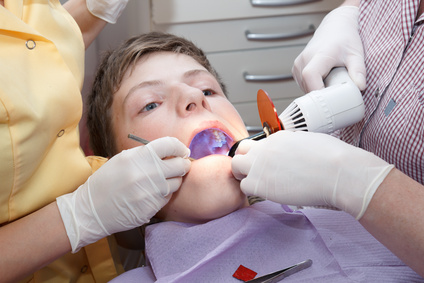Dental Sealant Protect Tooth Decay
A dental sealant is a thin, plastic coating applied to the chewing surfaces of teeth — usually the premolars and molars — to prevent tooth decay. The sealant quickly bonds into the depressions and grooves of the teeth, forming a protective shield over the enamel of each tooth.
In spite of the fact that by complete brushing and flossing can remove food particles and plaque from smooth surfaces of teeth, they cannot always get into all the nooks and crannies of the molars to remove the food and plaque. Sealants protect these vulnerable areas from tooth decay by “sealing out” plaque and food.
Children and teenagers are good candidates for sealants because of the likelihood of developing decay in the depressions and grooves of the premolars and molars. However, adults without decay or fillings in their molars can also benefit from sealants.
Typically, children should get sealants on their permanent molars and premolars as soon as these teeth come in. In this way, the sealants can protect the teeth through the cavity-prone years of ages 6 to 14. In some cases, dental sealants may also be appropriate for baby teeth, such as when a child’s baby teeth have deep depressions and grooves. Baby teeth play such an important role in holding the correct spacing for permanent teeth, so it’s important to keep these teeth healthy so they are not lost too early.
Sealant Application Steps:
Applying sealant is a simple and painless process. It takes only a few minutes for your dentist or hygienist to apply the sealant to seal each tooth. The application steps are as follows:
1. First the teeth that are to be sealed are thoroughly cleaned.
2. Each tooth is then dried, and cotton or another absorbent material is put around the tooth to keep it dry.
3. An acid solution is put on the chewing surfaces of the teeth to roughen them up, which helps the sealant bond to the teeth.
4. The teeth are then rinsed and dried.
5. Sealant is then painted onto the tooth enamel, where it bonds directly to the tooth and hardens. Sometimes a special curing light is used to help the sealant harden.
Life-Span of Dental Sealants
Typically, sealants last five to 10 years, but they should be checked at every dental appointment to make sure they’re still in place and check for chipping or wear. Having sealants doesn’t mean kids get a pass on brushing and flossing their teeth, but they may get fewer cavities and, therefore, need fewer fillings.
Does Insurance Cover the Cost of Sealants?
Many insurance companies cover the cost of sealants. Check with your dental insurance carrier to determine if sealants are covered under your plan.
For more information on teeth whitening please visit Professional Dental Care at Clear Dental Richmond
Tags: dental sealants for babies at Richmond Clear Dental BC, sealant dental service in Richmond Bc, sealant for Children and teenagers in clear Dental Richmond Bc
